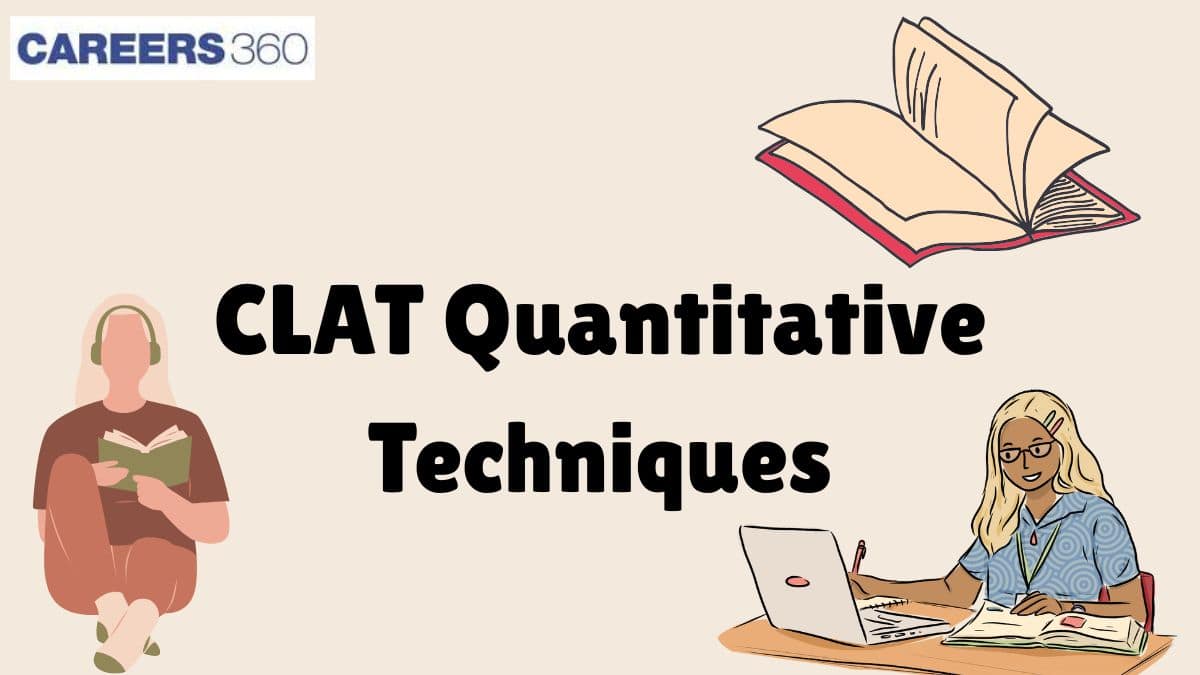Amity University-Noida Law Admissions 2026
Among top 100 Universities Globally in the Times Higher Education (THE) Interdisciplinary Science Rankings 2026
CLAT 2026 Quantitative Techniques: The CLAT 2026 exam is scheduled for Sunday, December 7, 2025, and will be conducted offline from 2:00 pm to 4:00 pm. A standout feature of CLAT is the presence of the maths section. Mathematics finds its way into the Common Law Admission Test through the Quantitative Techniques for CLAT section. In the CLAT syllabus, the CLAT quantitative techniques section is allotted only a 10% weightage, but it can make a big difference in the candidate's prospects of getting a good rank. The Quantitative Techniques section of CLAT 2026 will feature short sets of facts or textual/numerical information, followed by questions requiring basic mathematical application. The Consortium of National Law Universities (CNLU) has released the official notification and sample papers on its website, consortiumofnlus.ac.in. In this article, get to know about the CLAT Quantitative Techniques syllabus, the quantitative aptitude question paper, and a few preparation tips.
This Story also Contains

The quantitative techniques in CLAT 2026 test the candidate's basic mathematical ability. It evaluates the candidate's knowledge of basic maths problems, including basic calculations, profit and loss, ratio and proportion, and more. The CLAT quantitative techniques, mathematical operations have a 10th standard difficulty level or below.
| Trains for CLAT | Fractions as Division for CLAT |
| Relative Speed for CLAT | Divisibility Rule and Its Test |
| Basic Mathematical Operations for CLAT | Area & Perimeter of Triangle for CLAT |
Among top 100 Universities Globally in the Times Higher Education (THE) Interdisciplinary Science Rankings 2026
Ranked #18 amongst Institutions in India by NIRF | Ranked #1 in India for Academic Reputation by QS Rankings | 16 LPA Highest CTC
Similar to other sections in the CLAT exam, the CLAT Maths also contains different questions based on a given set of passages or data.
The Consortium of National Law Universities (CNLU) has specified that the quantitative section of the CLAT will cover short collections of propositions or facts, graphs, or other textual, visual, or diagrammatic representations of numerical data. The candidate has to answer the questions that follow this set of data.
It will test the candidate’s ability to:
Obtain, deduce, and alter the numerical data presented in texts, graphs, or any other form.
Perform mathematical operations in various areas. The topics will include basic algebra, ratio and proportion, statistical estimation, and mensuration. The mathematics asked in the exam is of the 10th-grade level
To obtain proficiency in these topics, some of the best books on CLAT Quantitative Aptitude that can help the candidate include the Class 10 NCERT Mathematics Textbook and Quantitative Aptitude by R.S. Aggarwal.
You may also read
Given below are important topics in the maths section of CLAT 2026
Basic Arithmetic: This includes fundamental mathematics that covers simple operations such as addition, subtraction, division, and multiplication.
Profit & Loss: This part covers finding out gains or losses incurred in an activity
Ratios and Proportions: Finding out the percentage increase or decrease and the mathematical relationship between two given situations
Mensuration: It deals with measurement, volume, and geometry.
Statistical Estimation: It covers analysing a given set of data and interpreting results
You may also check
| Particulars | Details |
Weightage | 10% |
Number of Questions | 10-14 MCQs |
Marks | 10-14 |
Negative Marking | -0.25 |

The quantitative section contains 10-14 multiple-choice questions, which is approximately 10% of the overall paper. Although the weightage given to the quantitative techniques for CLAT is less than the 20% weightage for other sections, it is of no less significance.
Candidates would do well to practise adequately through previous year CLAT question papers and CLAT sample question papers released by the CNLU to acquaint themselves with the CLAT paper pattern.
Here’s a question given below, which is extracted from the official UG-CLAT 2023 paper. Attempt it to find out your comfort level in the section.
World fruit production went up 54 per cent between 2000 and 2019, to 883 million tonnes. Five fruit species accounted for 57 per cent of the total production in 2019, down from 63 per cent in 2000. Use the data in the passage to answer the following questions
What was the world fruit production in 2000?
(A) 474 million tonnes
(B) 517 million tonnes
(C) 573 million tonnes
(D) 406 million tonnes
Of the five fruit species mentioned in the passage above, the share of bananas and plantains increased by 1 percentage point between 2000 and 2019, watermelons in 2019 was 6 percentage points lower than bananas and plantains in 2000, apples remained stable at 10%, and the percentage share of oranges and grapes reduced to half of bananas in 2019. What was the percentage of bananas and plantains in 2019
(A) 17%
(B) 18%
(C) 16%
(D) 21%
Of the watermelons in 2000, one-eighth perished, one-fifth of the remaining was sold to be juiced and 30% of the remaining was exported. If the percentage share of oranges in 2000 was equal to the percentage share of watermelons in 2019, how many watermelons were retained for home sale and consumption?
(A) 39.2 million tonnes
(B) 1.6 million tonnes
(C) 16.8 million tonnes
(D) 2.7 million tonnes
Assume that all grapes and apples were sold through a single organisation in 2000. Grapes and apples were sold to 4 different customers such that a certain quantity of apples were sold to the first customer, the same number of apples were sold to the second customer as to the first and a certain number of grapes were sold to that customer after which the apples were over. Twice the quantity of grapes sold to the second was sold to the third customer and twice the quantity sold to the third was sold to the fourth customer. The total quantity of grapes is equal to the total quantity of apples sold and the remaining grapes were stored. How many grapes were sold to each customer?
19.1 million tonnes
8.2 million tonnes
28.6 million tonnes
9.4 million tonnes
Frutopia and Fruitfix both sold oranges at the same selling price. However, Frutopia gave customers a 15% discount on the marked price, whereas Fruitfix sold the oranges for a discount of 20% on the marked price. If the marked price of oranges on Frutopia is 75/kg, what is the marked price of oranges on Fruitfix?
(A) 78
(B) 82
(C) 90
(D) 80
Given below are some good books for quantitative techniques for CLAT 2026
| Quantitative Aptitude for Competitive Examinations | R.S. Aggarwal |
| Mathematics for Class 10 | NCERT |
Candidates can find it difficult to prepare for the quantitative section in CLAT. However, it may not be as difficult as it seems. It requires continuous practice to ace the mathematics section because of the very nature of the subject. If candidates follow a study timetable and solve enough CLAT quantitative aptitude sample papers and mock tests, then they find this section easy. Candidates must also work on their reading and comprehension speed to succeed in this part. The questions can often be descriptive in nature, and with a superior ability to read and understand, one can get through the section quickly. Similarly, a few shortcuts and tricks to solve numerical problems can boost calculation speed to complete the section quickly.
Also, check -
Frequently Asked Questions (FAQs)
This section contains questions based on 10th grade level maths and includes topics such as basic algebra, ratio and proportion, mensuration and statistical estimation.
The quantitative aptitude section has 10-14 questions forming roughly 10% of the overall syllabus.
Yes. Though the weightage for the quantitative section is 10%, doing well in it can improve your chances of getting ahead of the competition.
Candidates can refer to class 10 NCERT mathematics textbook and also Quantitative Aptitude by RS Aggarwal. Solving sample papers and earlier question papers should also be part of one’s preparation.
The quantiative techniques in CLAT is a test of the candiadate's basic mathematical ability to peform basic mathematical calculations and work with numerical data.
On Question asked by student community
With an AIR of 34724 and OBC category rank of 7153, chances of getting a seat in DSNLU Visakhapatnam are low in early rounds. However, since you are already invited for counselling, there may be some chance in later rounds depending on seat vacancy and cut-off movement. You should participate
With a CLAT LLM rank of 13656, getting a top NLU is difficult. You may have chances in lower-ranked NLUs or private law universities, depending on seat availability and category.
You can check CLAT LLM counselling details here:
https://law.careers360.com/articles/clat-llm-cut-off
Hello there,
Having a 15000 general rank and 1740 as your SC category rank, your chances of securing a seat are very low. As per the previous trends, it is a direct no for you to get into the top-tier NLUs since the closing general rank is around 1500-3000. If
With a CLAT PG rank of 1257 in the SC category and being a woman candidate with Rajasthan domicile, you do have a realistic chance of securing admission to several National Law Universities, though the top NLUs may be difficult at this rank. Admission chances depend heavily on category-wise cut-offs,
With a CLAT PG rank of around 11,000, getting admission into the top National Law Universities (NLUs) is not likely, as their general category cut-offs usually close much earlier. However, you still have realistic chances in lower-ranked and newer NLUs, especially in the later rounds of CLAT counselling or through
Among top 100 Universities Globally in the Times Higher Education (THE) Interdisciplinary Science Rankings 2026
Excellent curriculum; an impressive range of electives, besides core law courses. Up to 100% merit scholarship on a first-come, first-served basis
Ranked #18 amongst Institutions in India by NIRF | Ranked #1 in India for Academic Reputation by QS Rankings | 16 LPA Highest CTC
AICTE & UGC Approved | NAAC A+ Accredited
NAAC A++ Approved | Curriculum Aligned with BCI & UGC
India's Largest University | BCI approved | Meritorious Scholarships up to 5 lacs |